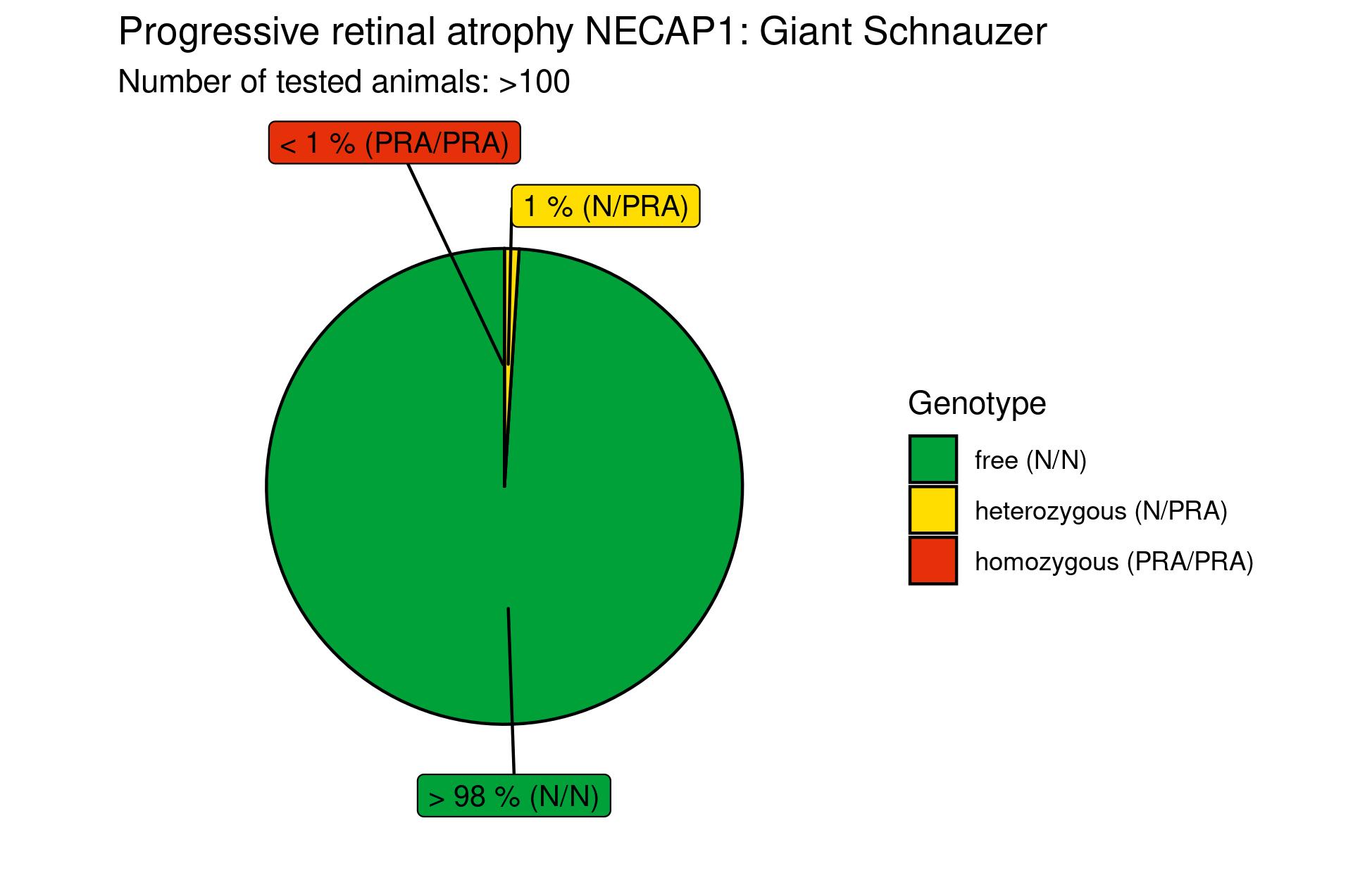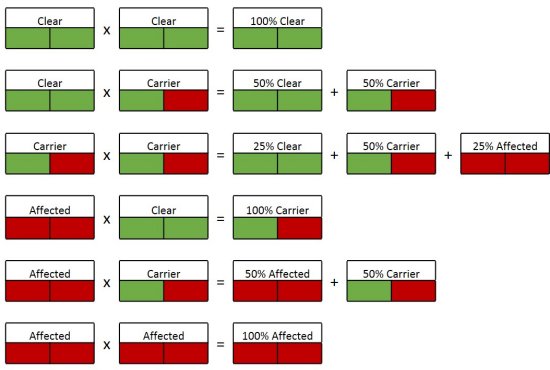
Progressive Retinal Atrophy – PRA5 (NECAP1)
Info
What is PRA?
Progressive retinal atrophy is a genetic eye disease that leads to gradual vision loss and eventually blindness. This type of PRA was discovered in a litter of UK bred Giant Schnauzers during 2016. Three affected littermates of European pepper/salt breeding were identified as affected, and subsequent testing with the existing prcd-PRA DNA test, proved that this was a different type. Samples from the affected dogs and close relatives were sent to the Animal Health Trust where a whole genome sequencing approach was used to identify the mutation (NECAP1) for this novel type of PRA. An additional 309 Giant Schnauzers were involved in the research from 3 different cohorts in the UK, Finland and Switzerland. Of these additional research dogs, a further 9 were found to be carriers, and carriers were seen in both black and pepper/salt Giants. The AHT estimated at the time that approximately 1 in 4715 giant schnauzers would be homozygous for this mutation, and 1 in 35 dogs (2.9%) would be carriers. The full research article can be found on the following link: Whole Genome Sequencing of Giant Schnauzer Dogs with Progressive Retinal Atrophy Establishes NECAP1 as a Novel Candidate Gene for Retinal Degeneration
Prevalence
Data provided by Laboklin (2024) from across Europe, including the UK, shows that 1% of Giant Schnauzers carry one copy of the mutation, and <1% are affected having 2 copies.

Age of Onset
The affected Giant Schnauzer littermates discovered in 2016 had symptoms and were diagnosed with PRA already at the age of 4 years prior to the research taking place.
Mode of Inheritance
The mode of inheritance is autosomal recessive, which means a dog will only be affected if they have 2 copies of the recessive gene, one from the sire and one from the dam. The result of the DNA test will be either clear, carrier or affected. See Breeding from a DNA Tested Dog for further information regarding the result and breeding advice.
Signs & Symptoms
Like other forms of PRA this disease leads to retinal degeneration and subsequent blindness.
Owners of affected dogs first notice that their dog becomes night blind, but this eventually progresses to severe visual dysfunction under both dim and bright light; finally degeneration can lead to total blindness.
Any variation of the following are common signs that your dog may be suffering this type of PRA:
- Cloudy eye surface or discoloration on the surface of the eye
- Cataracts
- Greenish tinge to the surface of the eye under certain light conditions
- Bumping into furniture
- Tripping over objects
- Reluctance to go out in the dark
- Reluctance to explore
- Reluctance to navigate stairs
Diagnosis
Diagnosis of PRA is usually made by examining the back of the eye with an ophthalmoscope to look for characteristic signs of retinal degeneration. This requires a specialist veterinary ophthalmologist. A genetic test for PRA5 (NECAP1) helps to diagnose this particular disease and is also a useful tool for breeders to eliminate the mutated gene from the dog population and avoid ever breeding an affected dog.
Prognosis
Unfortunately, the effects of PRA5 are irreversible, the disease cannot be cured, and it results in complete blindness for an affected dog. However, you dogs can be made more comfortable by keeping furniture in a familiar location and keeping the floor clear of obstacles. Going on a well-known route during walks can help to prevent anxiety. Animals may adapt well to vision loss especially with help from their owners. Training techniques can been used to help a dog to adapt and adjust to blindness.
Screening
To comply with the Kennel Club’s ‘Best Practice’ breeders should DNA test for PRA5 (NECAP1) prior to breeding
Where to go for a DNA Test
See the list of KC approved DNA testing laboratories:
Costs
The Giant Schnauzer Club have a discount voucher code for the Laboklin Giant Schnauzer bundle which consists of: HUU, prcd-PRA, DCM, PRA5 & DM
Contact the breed health co-ordinator for more information
Requirements for the DNA test
- The dog should be microchipped
- The Kennel Club require at least two forms of identification on the result certificate. These must include the dog’s microchip or tattoo number along with either the dog’s registered name or their registered number.
- Results must be of a recognised DNA test and from an approved laboratory for the result to be officially recorded by the KC.
Publication of Results
PRA5 (NECAP1) is part of the official KC DNA Testing Scheme, and as such DNA test results can be added to the KC database for official reporting.
Buyers
Advice for Puppy Buyers
Ideally choose a breeder where the sire and dam have been DNA tested. If one parent is a carrier or affected the other parent must be CLEAR.
Two carriers, two affected, or a carrier and an affected should not be bred together, as this will produce affected puppies.
Ask the breeder to provide information on the DNA status of a puppy and/or both parents. You can also check on the Kennel Club website link below.
Kennel Club Health Test Result Finder
DNA test results are published for this condition via the Kennel Club health test results finder.
Breeders
Advice for Breeders
In order to meet the Kennel Club’s ‘Best Practice’ Breeders should DNA test for PRA5 (NECAP1) before breeding.
If you have already had your Giant DNA tested you can now send the results to the KC for officially recording.
Email test certificates to: health.results@thekennelclub.org.uk
It is useful to test before breeding to know which dogs are carriers, and be able to breed safely. If you haven’t tested it’s not possible to know!
The DNA test can prevent puppies from being affected by this mutation.
The mode of inheritance for PRA5 (NECAP1) is a simple autosomal recessive gene. Therefore both the parents that produced an affected puppy would either have one or two copies of the mutant gene.
See breeding from a DNA Tested Dog
The probabilities of producing affected puppies from a simple autosomal recessive inheritance are shown below (actual numerical values will vary)

A ‘Clear‘ has 2 copies of the normal gene, is unaffected and cannot pass on a faulty gene.
A ‘Carrier‘ has 1 normal gene and 1 recessive abnormal gene, they are physically unaffected but may pass on the abnormal gene.
‘Affected‘ dogs have 2 copies of the defective gene of which they will pass on 1 of the affected genes to their offspring.
A mating that may produce affected puppies should not be carried out.
How To Help
Make a Donation to the GSHF
The purpose of the GSHF is to provide monies for research into inherited health problems in the Giant Schnauzer. All donations gratefully received.
